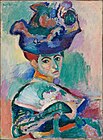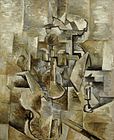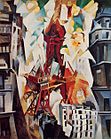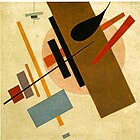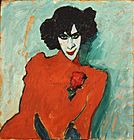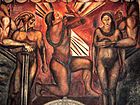20th-century Western painting
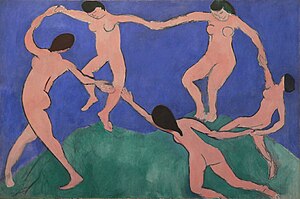
20th-century Western painting begins with the heritage of late-19th-century painters
Initially influenced by Toulouse-Lautrec, Gauguin, and other late-19th-century innovators,
Crystal Cubism was a distilled form of Cubism consistent with a shift between 1915 and 1916 towards a strong emphasis on flat surface activity and large overlapping geometric planes, practised by Braque, Picasso, Jean Metzinger, Albert Gleizes, Juan Gris, Diego Rivera, Henri Laurens, Jacques Lipchitz, Alexander Archipenko, Fernand Léger, and several other artists into the 1920s.[4]
During the years between 1910 and the end of World War I and after the heyday of cubism, several movements emerged in Paris.
In the first two decades of the 20th century, as Cubism evolved, several other important movements emerged;
Early 20th century
-
Henri Matisse, 1905, Fauvism
-
Pablo Picasso, 1907, early Cubism
-
Analytic Cubism
-
Metaphysical art (pre-Surrealism)
-
The Dream, 1910, Primitive Surrealism
-
František Kupka, Amorpha, Fugue in Two Colors, 1912, Orphism
Pioneers of abstraction
-
Robert Delaunay, 1911, Orphism
-
Piet Mondrian, 1911, early De Stijl
-
Franz Marc 1912, Der Blaue Reiter
-
Abstract Art
-
Robert Delaunay, 1912–1913, Orphism
-
Morgan Russell, 1913–14 Synchromism
-
Kazimir Malevich, 1916, Suprematism
-
Neo-Plasticism
-
Synthetic Cubism, Tubism
-
Stuart Davis, American modernism, 1921
-
Stuart Davis American Modernism 1922
Fauvism, Der Blaue Reiter, Die Brücke
-
Henri Matisse, Fauvism, 1905
-
André Derain, Fauvism, 1906
-
Maurice de Vlaminck, Fauvism, 1906
-
Franz Marc, Der Blaue Reiter, 1913–14
-
Ernst Kirchner, Die Brücke, 1913
-
Otto Mueller, Die Brücke, 1919
Les Fauves (French for The Wild Beasts) were early-20th-century painters, experimenting with freedom of expression through color. The name was given, humorously and not as a compliment, to the group by art critic
"How do you see these trees? They are yellow. So, put in yellow; this shadow, rather blue, paint it with pure ultramarine; these red leaves? Put in vermilion."
The leaders of the movement were Henri Matisse and André Derain—friendly rivals of a sort, each with his own followers. Ultimately Matisse became the yang to Picasso's yin in the 20th century. Fauvist painters included Albert Marquet, Charles Camoin, Maurice de Vlaminck, Raoul Dufy, Othon Friesz, the Dutch painter Kees van Dongen, and Picasso's partner in Cubism, Georges Braque amongst others.[9]
Fauvism, as a movement, had no concrete theories, and was short lived, beginning in 1905 and ending in 1907. The Fauves had only three exhibitions. Matisse was seen as the leader of the movement, due to his seniority in age and prior self-establishment in the academic art world. His 1905 portrait of Mme. Matisse, The Green Line (above), caused a sensation in Paris when it was first exhibited. He said he wanted to create art to delight; art as a decoration was his purpose and it can be said that his use of bright colors tries to maintain serenity of composition. In 1906 at the suggestion of his dealer

By 1907 Fauvism no longer was a shocking new movement, soon it was replaced by
Der Blaue Reiter was a German movement lasting from 1911 to 1914, fundamental to Expressionism, along with
Wassily Kandinsky, Franz Marc, August Macke, Alexej von Jawlensky, whose psychically expressive painting of the Russian dancer Portrait of Alexander Sakharoff, 1909 is in the gallery above, Marianne von Werefkin, Lyonel Feininger and others founded the Der Blaue Reiter group in response to the rejection of Kandinsky's painting Last Judgement from an exhibition. Der Blaue Reiter lacked a central artistic manifesto, but was centered around Kandinsky and Marc. Artists Gabriele Münter and Paul Klee were also involved.
The name of the movement comes from a painting by Kandinsky created in 1903. It is also claimed that the name could have derived from Marc's enthusiasm for horses and Kandinsky's love of the colour blue. For Kandinsky, blue is the colour of spirituality: the darker the blue, the more it awakens human desire for the eternal.[13]
Expressionism, Symbolism, American Modernism, Bauhaus
-
Gustav Klimt, Expressionism, 1907–1908
-
Arthur Dove, early American modernism, 1911
-
Patrick Henry Bruce, American modernism, 1917–1918


Dada and Surrealism
-
Giorgio de Chirico, The Red Tower (La Tour Rouge), 1913, early Surrealism
-
Francis Picabia, Machine Turn Quickly 1916, Dada
-
André Masson, 1922, Surrealism



In 1924
were very influential, especially in the United States during the 1940s.Throughout the 1930s, Surrealism continued to become more visible to the public at large. A Surrealist group developed in Britain and, according to Breton, their 1936 London International Surrealist Exhibition was a high-water mark of the period and became the model for international exhibitions. Surrealist groups in Japan, and especially in Latin America, the Caribbean and in Mexico produced innovative and original works.
Dalí and Magritte created some of the most widely recognized images of the movement. The 1928/1929 painting This Is Not A Pipe by Magritte is the subject of a Michel Foucault 1973 book, This is not a Pipe (English edition, 1991), that discusses the painting and its paradox. Dalí joined the group in 1929, and participated in the rapid establishment of the visual style between 1930 and 1935.
Surrealism as a visual movement had found a method: to expose psychological truth by stripping ordinary objects of their normal significance, in order to create a compelling image that was beyond ordinary formal organization, and perception, sometimes evoking empathy from the viewer, sometimes laughter and sometimes outrage and bewilderment.[21]
1931 marked a year when several Surrealist painters produced works which marked turning points in their stylistic evolution: in one example liquid shapes become the trademark of Dalí, particularly in his The Persistence of Memory, which features the image of watches that sag as if they are melting. Evocations of time and its compelling mystery and absurdity.[22]
The characteristics of this style – a combination of the depictive, the abstract, and the psychological – came to stand for the alienation which many people felt in the modernist period, combined with the sense of reaching more deeply into the psyche, to be "made whole with one's individuality."[23][24]
Max Ernst studied philosophy and psychology in Bonn and was interested in the alternative realities experienced by the insane. His paintings, such as Murdering Airplane (1920), may have been inspired by the
During the 1920s André Masson's work was enormously influential in helping the young artist Joan Miró find his roots in the new Surrealist painting. Miró acknowledged in letters to his dealer Pierre Matisse the importance of Masson as an example to him in his early years in Paris.
Long after personal, political and professional tensions have fragmented the Surrealist group into thin air and ether, Magritte, Miró, Dalí and the other Surrealists continue to define a visual program in the arts. Other prominent surrealist artists include Giorgio de Chirico, Méret Oppenheim, Toyen, Grégoire Michonze, Roberto Matta, Kay Sage, Leonora Carrington, Dorothea Tanning, and Leonor Fini among others.
Neue Sachlichkeit, Social realism, regionalism, American Scene painting, Symbolism
-
Neue Sachlichkeit
-
Neue Sachlichkeit
-
Regionalism
-
American realism
-
José Orozco, detail of mural Omnisciencia, 1925, Mexican Social Realist Mural Movement
-
Pop Art)
-
Pop Art)
-
Charles Demuth, 1931, Precisionism
-
Stanton Macdonald-Wright 1920, Airplane Synchromy in Yellow-Orange, Synchromism
-
Man, Controller of the Universe), originally created in 1934, Mexican muralism movement
During the 1920s and the 1930s and the
In Germany
Diego Rivera is perhaps best known by the public for his 1933 mural,
During the 1930s radical leftist politics characterized many of the artists connected to
In its final form, Guernica is an immense black and white, 3.5 metre (11 ft) tall and 7.8 metre (23 ft) wide mural painted in oil. The mural presents a scene of death, violence, brutality, suffering, and helplessness without portraying their immediate causes. The choice to paint in black and white contrasts with the intensity of the scene depicted and invokes the immediacy of a newspaper photograph.[28]
Picasso painted the mural sized painting called
During the
Abstract expressionism
The 1940s in New York City heralded the triumph of American
Post-Second World War American painting, called Abstract Expressionism, included artists like
Technically Surrealism was an important predecessor for Abstract expressionism with its emphasis on spontaneous, automatic or subconscious creation. Jackson Pollock's dripping paint onto a canvas laid on the floor is a technique that has its roots in the work of André Masson. Another important early manifestation of what came to be abstract expressionism is the work of American Northwest artist Mark Tobey, especially his "white writing" canvases, which, though generally not large in scale, anticipate the "all over" look of Pollock's drip paintings.
Additionally, abstract expressionism has an image of being rebellious, anarchic, highly idiosyncratic and, some feel, rather nihilistic. In practice, the term is applied to any number of artists working (mostly) in New York who had quite different styles, and even applied to work which is not especially abstract nor expressionist. Pollock's energetic "
Clyfford Still, Barnett Newman, Adolph Gottlieb, and the serenely shimmering blocks of color in Mark Rothko's work (which is not what would usually be called expressionist and which Rothko denied was abstract), are classified as abstract expressionists, albeit from what Clement Greenberg termed the Color field direction of abstract expressionism. Both Hans Hofmann and Robert Motherwell (gallery) can be comfortably described as practitioners of action painting and Color field painting.

Abstract expressionism has many stylistic similarities to the Russian artists of the early twentieth century such as Wassily Kandinsky. Although it is true that spontaneity or of the impression of spontaneity characterized many of the abstract expressionists works, most of these paintings involved careful planning, especially since their large size demanded it. An exception might be the drip paintings of Pollock. Why this style gained mainstream acceptance in the 1950s is a matter of debate. American
Although Abstract expressionism spread quickly throughout the United States, the major centers of this style were New York City and California, especially in the New York School, and the San Francisco Bay area. Abstract expressionist paintings share certain characteristics, including the use of large canvases, an "all-over" approach, in which the whole canvas is treated with equal importance (as opposed to the center being of more interest than the edges). The canvas as the arena became a credo of Action painting, while the integrity of the picture plane became a credo of the Color Field painters. Many other artists began exhibiting their abstract expressionist related paintings during the 1950s including Alfred Leslie, Sam Francis, Joan Mitchell, Helen Frankenthaler, Cy Twombly, Milton Resnick, Michael Goldberg, Norman Bluhm, Ray Parker, Nicolas Carone, Grace Hartigan, Friedel Dzubas, and Robert Goodnough among others.
During the 1950s, Color Field painting initially referred to a particular type of
In Europe there was the continuation of Surrealism, Cubism, Dada and the works of
among others are considered important figures in post-war European painting.Eventually abstract painting in America evolved into movements such as
Realism, Landscape, Figuration, Still-Life, Cityscape
During the 1930s through the 1960s as abstract painting in America and Europe evolved into movements such as
After World War II the term
Pop art
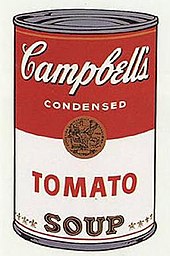
Pop art is exemplified by artists:
Earlier in England in 1956 the term Pop Art was used by Lawrence Alloway for paintings that celebrated consumerism of the post World War II era. This movement rejected Abstract expressionism and its focus on the hermeneutic and psychological interior, in favor of art which depicted, and often celebrated material consumer culture, advertising, and iconography of the mass production age.[39] The early works of David Hockney whose paintings emerged from England during the 1960s like A Bigger Splash, and the works of Richard Hamilton, Peter Blake, and Eduardo Paolozzi, are considered seminal examples in the movement.
While in the downtown scene in New York's
Art Brut, New Realism, Bay Area Figurative Movement, Neo-Dada, Photorealism
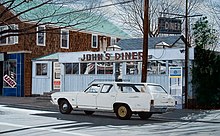
During the 1950s and 1960s as abstract painting in America and Europe evolved into movements such as
Neo-Dada is a movement that started in the 1950s and 1960s and was related to Abstract expressionism only with imagery. Featuring the emergence of combined manufactured items, with artist materials, moving away from previous conventions of painting. This trend in art is exemplified by the work of Jasper Johns and Robert Rauschenberg, whose "combines" in the 1950s were forerunners of Pop Art and Installation art, and made use of the assemblage of large physical objects, including stuffed animals, birds and commercial photography. Robert Rauschenberg, Jasper Johns, Larry Rivers, John Chamberlain, Claes Oldenburg, George Segal, Jim Dine, and Edward Kienholz among others were important pioneers of both abstraction and Pop Art; creating new conventions of art-making; they made acceptable in serious contemporary art circles the radical inclusion of unlikely materials as parts of their works of art.
Geometric abstraction, Op Art, Hard-Edge, Color field, Minimal Art, New Realism
-
New Realism
During the 1960s and 1970s abstract painting continued to develop in America through varied styles.
In 1965, an exhibition called
Shaped canvas, Washington color school, abstract illusionism, lyrical abstraction
-
Abstract Illusionism
-
Lyrical Abstraction
Color Field painting clearly pointed toward a new direction in American painting, away from
Color Field painting sought to rid art of superfluous rhetoric. Artists like
The Andre Emmerich Gallery, the
Another related movement of the late 1960s,
Lyrical Abstraction in the late 1960s is characterized by the paintings of
Monochrome, minimalism, postminimalism


Artists such as
Because of a tendency in Minimalism to exclude the pictorial, illusionistic and fictive in favor of the literal—as demonstrated by Robert Mangold, who understood the concept of the shape of the canvas and its relationship to objecthood—there was a movement away from painterly and toward sculptural concerns. Donald Judd had started as a painter, and ended as a creator of objects. His seminal essay, "Specific Objects" (published in Arts Yearbook 8, 1965), was a touchstone of theory for the formation of Minimalist aesthetics. In this essay, Judd found a starting point for a new territory for American art, and a simultaneous rejection of residual inherited European artistic values. He pointed to evidence of this development in the works of an array of artists active in New York at the time, including Jasper Johns, Dan Flavin and Lee Bontecou. Of "preliminary" importance for Judd was the work of George Earl Ortman,[50] who had concretized and distilled painting's forms into blunt, tough, philosophically charged geometries. These Specific Objects inhabited a space not then comfortably classifiable as either painting or sculpture. That the categorical identity of such objects was itself in question, and that they avoided easy association with well-worn and over-familiar conventions, was a part of their value for Judd.
In a much more general sense, one might find European roots of Minimalism in the geometric abstractions painters in the Bauhaus, in the works of Piet Mondrian and other artists associated with the movement DeStijl, in Russian Constructivists and in the work of the Romanian sculptor Constantin Brâncuși. American painters such as Brice Marden and Cy Twombly show a clear European influence in their pure abstraction, minimalist painting of the 1960s. Ronald Davis polyurethane works from the late 1960s pay homage to the Broken Glass of Marcel Duchamp.
This movement was heavily criticised by high modernist formalist art critics and historians. Some anxious critics thought Minimalist art represented a misunderstanding of the modern dialectic of painting and sculpture as defined by critic
Still other important innovations in abstract painting took place during the 1960s and the 1970s characterized by
Neo-expressionism
In the late 1960s the
In the late 1970s and early 1980s, there was also a return to painting that occurred almost simultaneously in Italy, Germany, France and
During the late 1970s in the United States painters who began working with invigorated surfaces and who returned to imagery like
Neo-expressionism was a style of modern painting that became popular in the late 1970s and dominated the art market until the mid-1980s. It developed in Europe as a reaction against the conceptual and minimalistic art of the 1960s and 1970s. Neo-expressionists returned to portraying recognizable objects, such as the human body (although sometimes in a virtually abstract manner), in a rough and violently emotional way using vivid colours and banal colour harmonies. The veteran painters Philip Guston, Frank Auerbach, Leon Kossoff, Gerhard Richter, A. R. Penck and Georg Baselitz, along with slightly younger artists like Anselm Kiefer, Eric Fischl, Susan Rothenberg, Francesco Clemente, Damien Hirst, Jean-Michel Basquiat, Julian Schnabel, Keith Haring, and many others became known for working in this intense expressionist vein of painting.
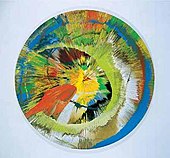
Contemporary painting into the 21st century
At the beginning of the 21st century Contemporary painting and Contemporary art in general continues in several contiguous modes, characterized by the idea of pluralism.[55][56]
Mainstream painting has been rejected by artists of the postmodern era in favor of artistic pluralism.[57] According to art critic Arthur Danto there is an anything goes attitude that prevails; an "everything going on", and consequently "nothing going on" syndrome; this creates an aesthetic traffic jam with no firm and clear direction and with every lane on the artistic superhighway filled to capacity.[58][59]
See also
- Art periods
- Australian art
- Contemporary art
- Hierarchy of genres
- History of art
- History of painting
- History painting
- Indian painting
- Japonism
- Lists of painters
- Lives of the Most Excellent Painters, Sculptors, and Architects
- Modern art
- Modernism
- Painting
- Painting in the Americas before European colonization
- Renaissance art
- Self-portrait
- Visual art of the United States
- Visual arts by indigenous peoples of the Americas
- Western painting
References
- ISBN 978-0-31329-752-6.
- ^ "Cubism: The Leonard A. Lauder Collection". Metropolitan Museum of Art. October 10, 2014. Retrieved June 30, 2019.
- ISBN 0-87587-041-4.
- ISBN 978-0-30003-468-4.
- ^ "Giorgio de Chirico. The Song of Love. Paris, June-July 1914". The Museum of Modern Art. Retrieved June 30, 2019.
- ^ Herbert, Robert L. (1968). Neo-Impressionism (Exhibition catalogue). New York: Solomon R. Guggenheim Foundation.
- ISBN 978-0-67942-627-1.
- ISBN 978-0-30680-595-0.
- ISBN 0-87070-638-1.
- ^ Rosenthal, Tom (4 December 2005). "Derain's London paintings at the Courtauld Gallery". The Independent.[dead link]
- ISBN 0-87070-676-4.
- ^ "Fritz Bleyl (1880-1966)". Brücke Museum. Archived from the original on March 16, 2018. Retrieved September 7, 2007.
- ^ "Art Term: Der Blaue Reiter". Tate. Retrieved August 10, 2009.
- ^ Agee & Rose (1979), p. 8.
- ^ Schjeldahl, Peter (July 30, 2007). "Modern Love: Gerald and Sara Murphy at work and at play". The New Yorker. Retrieved June 30, 2019.
- ISBN 978-0-69716-763-7.
- The World & I. pp. 196–201. Archived from the originalon October 17, 2008. Retrieved August 28, 2007 – via JasonKaufman.com.
- ^ "Modern Art and America: Alfred Stieglitz and His New York Galleries". National Gallery of Art. 2000. Archived from the original on December 22, 2015. Retrieved November 11, 2008.
- ISBN 978-0-19-280254-5.
- ^ Spector, Nancy. "The Tilled Field, 1923–1924". Solomon R. Guggenheim Museum. Archived from the original on September 25, 2008. Retrieved May 30, 2008.
- ^ Breton, André (1924). "Manifeste du surréalisme" [Manifestoes of Surrealism]. Bibliothèque nationale de France (in French). Retrieved June 30, 2019.
- ^ "The Persistence of Memory (1931)". Museum of Modern Art. Retrieved June 30, 2019.
- ISBN 978-0-47206-182-2.
- ISBN 978-0-22617-411-2.
- ^ "Max Ernst, 'Men Shall Know Nothing of This', (1923)". Tate. Retrieved June 30, 2019.
- ^ "Art Terms: Neue Sachlichkeit". Tate. Retrieved June 30, 2019.
- ISBN 978-0-74860-140-0.
- ^ Moffat, Charles. "Pablo Picasso". Art History Archive. Retrieved 14 June 2007.
- ^ Fineman, Mia (June 8, 2005). "The Most Famous Farm Couple in the World". Slate. Retrieved June 30, 2019.
- ^ de Kooning, Willem. "Woman V (1952–53 )". National Gallery of Australia. Archived from the original on December 21, 2016. Retrieved June 30, 2019.
- ^ Piper (1986), p. 635.
- ^ "Andrew Wyeth, 'Christina's World' (1948)". Museum of Modern Art. 2007. Retrieved June 30, 2019.
- ISBN 3-7913-1664-8.
- ISBN 0-8133-3520-5.
- ^ Schmied (1996), p.20.
- ^ Peppiatt (1996), p.148.
- ^ Hendrickson (1988), p. 31.
- ^ Kimmelman, Michael (September 30, 1997). "Roy Lichtenstein, Pop Master, Dies at 73". The New York Times. Retrieved November 12, 2007.
- ISBN 0-393-04401-7.
- ^ Dubuffet, Jean, L'Art brut préféré aux arts culturels (1949), translated into English in Art brut. Madness and Marginalia, a special issue of Art & Text, No. 27, 1987, pp. 31-33.
- ^ Fenton, Terry. "Appreciating Noland". Kenneth Noland: Master of Color Abstraction. Retrieved April 30, 2007.
- ISBN 978-0-71342-438-6.
- ^ Aldrich, Larry (November–December 1969). "Young Lyrical Painters". Art in America. 57 (6): 104–113.
- ^ OCLC 15937079.
- ^ "Colorscope: Abstract Painting 1960-1979 (March 20 - August 15, 2010)". Santa Barbara Museum of Art. Archived from the original on April 19, 2010.
- ^ a b Douglas, Sarah (March 2007). "Movers and Shakers, New York: Leaving C&M". Art+Auction. XXX (7).
- ^ Martin, Ann Ray; Junker, Howard (29 July 1968). "The New Art: It's Way, Way Out". Newsweek. pp. 3, 55–63.
- ^ Aldrich (1971).
- ^ "Minimalism". Encyclopædia Britannica. 19 April 2017.
- ^ Long, Jim (December 8, 2006). "George Ortman". The Brooklyn Rail. Retrieved June 30, 2019.
- ^ Wolf, Justin. "Neo-Expressionism Movement Overview". The Art Story. Retrieved June 30, 2019.
- ^ "Art Term: Neo-Expressionism". Tate. Retrieved June 30, 2019.
- ^ Plagens, Peter (February 21, 1993). "A Matter of Horsepower". Newsweek. Retrieved June 30, 2019.
- ISBN 978-0-19923-965-8.
- ^ Cotter, Holland (June 25, 2015). "'The Contemporaries', 'Painting Now' and More". The New York Times. Retrieved June 30, 2019.
- ^ "Understanding Contemporary Art: From Pop to Pluralism". Smithsonian Associates. Retrieved June 30, 2019.
- ^ "About Contemporary Art (Education at the Getty)". J. Paul Getty Museum. Retrieved June 30, 2019.
- ISBN 0-691-00299-1.
- ^ Cloweny, David W. "Arthur Danto". Rowan University. Archived from the original on December 27, 2009. Retrieved June 30, 2019.
Bibliography
- Agee, William C.; OCLC 5727281.
- OCLC 659382497.
- Greenberg, Clement (1961). Art and Culture: Critical Essays. Boston, Massachusetts: Beacon Press.
- Hendrickson, Janis (1988). Roy Lichtenstein. Cologne, Germany: ISBN 3-8228-0281-6.
- ISBN 978-1-56663-708-4.
- O'Connor, Francis V. (1967). Jackson Pollock (Exhibition catalogue). New York: OCLC 165852.
- Orford, Emily-Jane Hills (2008). The Creative Spirit: Stories of 20th Century Artists. Ottawa, Canada: Baico Publishing. ISBN 978-1-897449-18-9.
- ISBN 978-0-51762-336-7.
- ISBN 978-0-69112-678-4.
External links
- "History of Painting". beyondbooks.com. Archived from the original on March 13, 2007.
- "History of Art: From Paleolithic Age to Contemporary Art". all-art.org. Archived from the original on 2020-11-19. Retrieved 2009-07-12.
- Hughes, Robert. "Van Eyck". Artchive.
- Kandinsky, Wassily (June 28, 2004). "Concerning the Spiritual in Art". Minnesota State University Moorhead. Archived from the original on June 7, 2011. Retrieved May 28, 2007.

